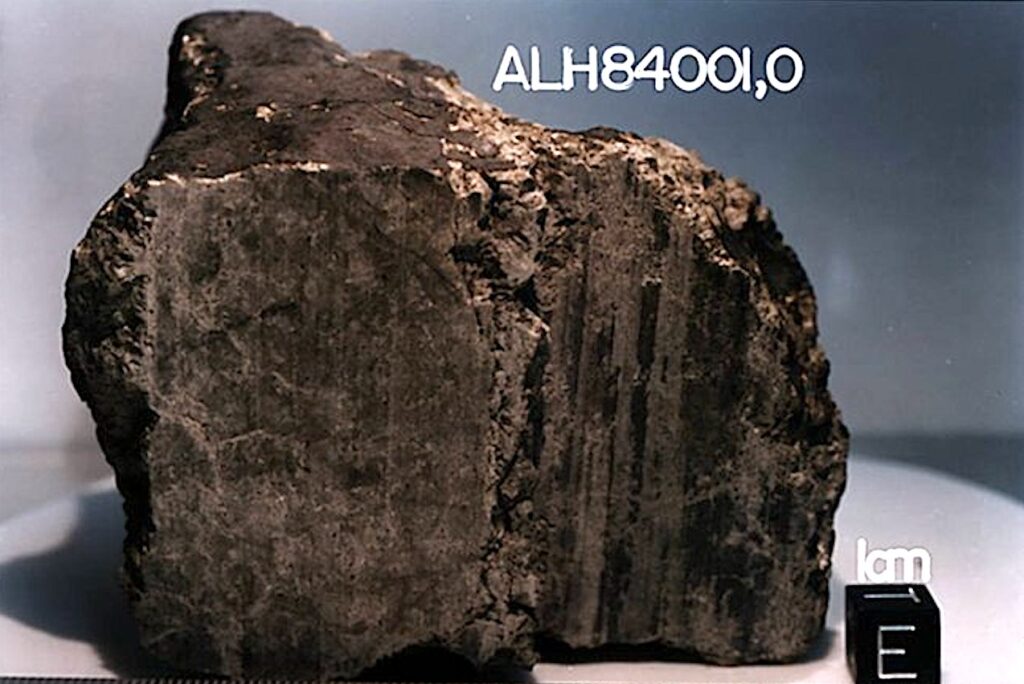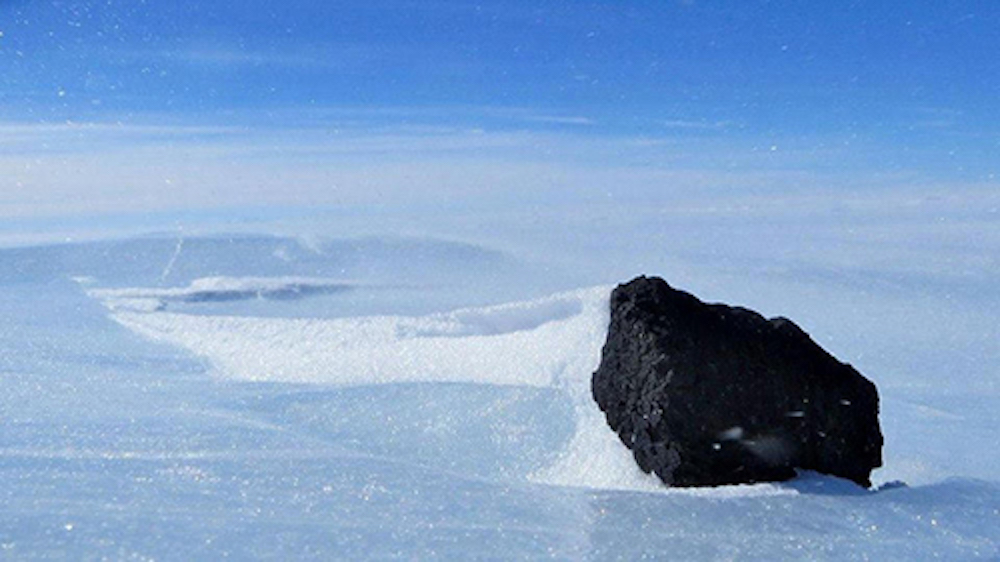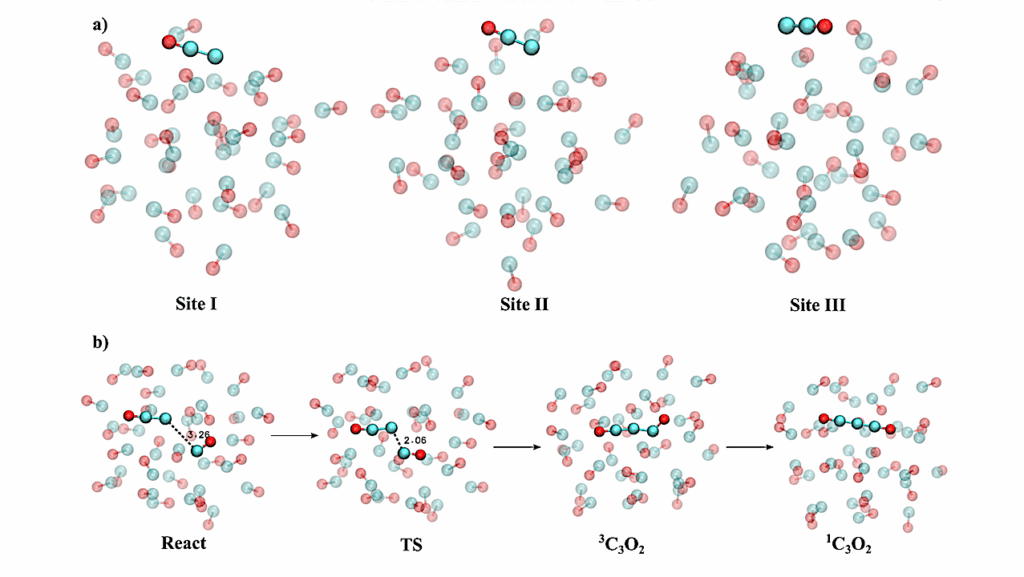Hitchhiking On A Meteorite: Is There Mars Life On Earth?

After circling the sun for several million years a piece of Mars is about to land on Earth Could Mars life have hitched a ride?
Various space agencies have been planning for sample return mission from Mars for years. Yet Mars itself has been providing a steady stream of samples (in the form of meteorites) since the dawn of the solar system. All we have to do is go out and pick them up off the ground.
Estimates of the amount of material that has been thrown from Mars to Earth across the history of the solar system are as high as 1 billion tons – that’s 1012 pounds or 4.5 x 1012 kg. Some estimates suggest that the number of individual meteorites could number in the billions. That’s a mountain – one piece at a time.
Some of these meteorites can take millions of years to make the trip. Others can do so in only a few thousand years. While it is interesting enough that planets swap rocks, given our curiosity about Mars’ life bearing potential, many wonder whether one of these rocks have brought viable organisms from Mars to Earth?
While it isn’t an everyday occurrence, it is rather straightforward for a rock to make it from the surface of Mars to the surface of Earth. However, it is quite another (assuming that there is – or was life on Mars) for a rock to carry viable organisms between one world and another. Upon first consideration, one would expect that the fiery plunge into Earth’s thick atmosphere would fry anything inside a meteorite. Just as firewalkers manage to traverse simmering coals, it is possible – albeit theoretically – to send organisms inside a rock between one planet and another – including a blazing descent through Earth’s atmosphere.

Perhaps the most famous Mars meteorite is ALH84001. It is within this meteorite that a number of NASA scientists claim to have found chemical and morphological evidence – fossils – of ancient Mars life. While their evidence is compelling (it captivated the world’s attention for several weeks in August 1996) not everyone shares the discoverers’ certainty that evidence of ancient Martian life was been found. Regardless of where you sit on this debate, it is important to note that the announcement spurred many to revisit a tantalizing thought many thought had been put to rest 20 years earlier: the possibility that live may have existed on Mars.
While ALH84001 itself may have grabbed the headlines, countless other rocks have arrived on Earth with no fanfare at all. The trip taken by ALH84001 can serve as an illustration of the conveyor belt that exists between Earth and Mars.
How do you know it is from Mars?
To date, several dozen meteorites have been classified as having come from Mars. The most recent find was announced in March 2002 and involved fragments found in the Sahara desert in northwest Africa. Meteorites thought to come from Mars are often referred to as “SNC” meteorites. SNC stands for Shergotty, Nakhla, and Chassigny – location names associated with the first three meteorites (originally found in 1865, 1911, and 1815 respectively) now identified as being from Mars. Curiously, despite being the most famous Mars meteorite, ALH84001 is not an SNC meteorite. It is much, much older than the SNCs – all of which are all less than 1.3 billion years in age.
The evidence that SNC meteorites are from Mars revolves around a careful analysis of gases trapped within glass bodies inside these meteorites. These small glass “inclusions” formed on Mars and trapped small amounts of the local atmosphere in the process. The case for a Martian origin was made with an analysis of meteorite EETA79001. The gases sampled from the small glass inclusions inside EETA79001 chemically and isotopically match the gas composition of Mars’ atmosphere as observed by the two Viking lander spacecraft on the surface of Mars.
In addition to the chemical analysis (which was the real clincher) there is the structure of the meteorites themselves. All of the SNC meteorites show some amount of shock damage – damage that could result from the initial shock that threw them out – and then off of the surface of Mars. The violent nature of such a power jolt would likely fragment weaker rocks – such as sedimentary rocks. As such, one would expect that only relatively strong rocks – such as those formed by melting (igneous) would be able to make the trip intact. Indeed, all SNC meteorites yet discovered are igneous rocks. Further chemical analysis of SNC’s in comparison with Viking data suggests that some of the Martian surface may be covered with soil composed of weathered basalt similar in nature to material found in some of the SNCs.
Results from the twin Viking lander missions showed a surface apparently devoid of life with only some exotic chemistry – chemistry that Carl Sagan once described as “self sterilizing”. Of course – we looked for Earth-like life on the surface and have yet to look within Mars itself. With the discovery of life in previously unheard of – indeed bizarre places on Earth, we now know that many other locations on Mars will have to be examined before the answer of life on Mars can be answered.
Getting here
The “parent” rock from which ALH 84001 came was formed from molten lava 4.5 billion years ago. 500 million years later, a strong shock (a large asteroid impact perhaps) fractured the parent rock. 3.6 billion years ago, mineral rich water flowed through cracks in the rocks leaving behind carbonate deposits. It is in association with the carbonate granules that the putative Martian fossils were found. Another, much more recent shock event once again disturbed the rock. It is possible that this shock resulted from the large impact event which eventually threw ALH84001 off of the surface of Mars.
The impact would have been a rather violent event. In order to leave Mars, ALH84001 would have had to reach a speed of 5.4 km/sec – that’s 18,000 km/hr (11,000 mph).
Calculations show that a rather large impact – one involving an impactor several kilometers in diameter – would have been required. The rocks that made it into space were also of a certain size range. Large chunks would have fallen back to the surface. Small rocks would have been pulverized. In a variation on the fable of Goldilocks, some rocks were not too big and not too small and made if into space without being shattered.
The exact date that ALH84001 was blasted off Mars is not certain. However it was no sooner than 16 or so million years ago. Estimations of its transit time between Mars and Earth are determined from the cosmic ray exposure of its surface as it moved naked through space. The rock may have been part of a larger body in which case the impact could have been much more ancient (since the portion we know as ALH84001 could have been shielded from cosmic rays). The rock could have been roughly the same size throughout its trip – with constant cosmic ray exposure at its surface in which case the 16 million year estimate would be more likely.
Once it left Mars, ALH84001 went into its own orbit around the sun. Each time its orbit came back close to Mars it was altered. Combined with other gravitational influences in the solar system, ALH84001 eventually found itself in a solar orbit that intersected with Earth.
While a lot of rocks make it from Mars to Earth, the vast majority never do. Indeed, as few as 1 in 10 million rocks blasted off of Mars make the trip to Earth. Indeed, it is thought that as much as 1/3 of all rocks blasted off of planets (not just Mars) will eventually be ejected from our solar system altogether due to gravitational interactions with the giant planets (primarily Jupiter and Saturn). Some of these rocks could make it to the nearest stars every 100 million years or so.
After entering Earth’s atmosphere, the rock landed in Antarctica. Based on where it was found and the condition of its outer surface, it is probable that it arrived around 13,000 years ago. Humans first encountered (and named) ALH84001 in 1984 when it was picked up off of the surface in the Allan Hills (hence the “ALH”) region of Antarctica by an ANSMET (ANtarctic Search for METeorites) expedition. ANSMET is sponsored by the National Science Foundation’s Office Polar Programs.

Waiting to be picked up.
ALH84001 then languished in a collection container until some years later when a mineralogical analysis – and comparison with SNC meteorites – showed enough similarities to conclude that it was from Mars.
Panspermia (“seeds everywhere”) is the name associated with the idea that life can travel through space from one world – or one solar system to another. While panspermia remains an unproven theory, studies involving meteorites thrown from Mars to Earth have led some scientists to see if life could be transported between worlds – and survive the trip. The answers that have been uncovered have caused many scientists to reconsider an idea that many of them once scoffed at.
Many things need to happen if life is to make the trip from Mars to Earth inside a rock. To begin with, the rock blasted off of Mars needs to have come from a location where life (again, if there is life) actually exists. Second, the lifeforms need to be located within the rock.
The take off would be quite a kick in the pants. To see if bacteria could survive the shock biologists have put them in high-pressure vises and fired bacteria laden bullets into clay. They’ve even shot them out of a cannon. The conditions of these tests are very similar to the sudden accelerations and shocks bacteria within a meteorite would experience. In each case, significant numbers of bacteria survived.
Not only was the trip rough – it was hot. However, research has shown that the interior of meteorites such as ALH84001 can remain rather pleasant – even as the rock hurtles through Earth’s atmosphere at supersonic speed causing the outer crust to melt. Indeed, the interior of this meteorite may never have exceeded 40C (100F) during its trip from Mars to Earth.
Of course, there was that long trip between Mars and Earth when the rock would have gotten rather cold. It would have also been exposed to microgravity, radiation, extreme dryness, vacuum conditions, and other hazards. Microgravity: minimal gravity effects have not been shown to be lethal to microorganism. In some case they seem to do better in microgravity.
Given the paucity of nutrition and clement conditions inside a meteorite in space required for organisms to remain alive – even for short periods, it is almost certain that any lifeforms that survive the trip are in some sort of state of dormancy. During dormancy many of life’s processes slow down and come to a halt. In so doing, the ability to survive rough times is enhanced. A number of lifeforms on Earth have been shown to survive rather severe conditions while dormant.
Some bacteria have been revived from permafrost that is several millions of years old. Other research, most notably on bacteria recovered from the gut of bees fossilized in amber 25-40 million years ago suggest that revival can occur after many millions of years. Bacteria recently sent into space inside of salt crystals survive the trip rather nicely. Remaining essentially inert while dormant solves a host problems about the trip itself. But others remain.
Dormancy can reduce an organism’s vulnerability considerably, but it cannot eliminate it, Radiation either in the form of external sources, or from the rock itself can eventually lead to a slow but lethal degradation of the biomolecules that make up an organism. Given the size of the rock and where organism are located it is possible that they can be shielded from most – if not all external radiation sources. Research on bacteria exposed to the space environment have shown that those which die can serve as radiation shields for those that remain alive underneath.
This leaves internal radiation sources to worry about. So long as the trip is short – a few million years – it is possible that any accumulated damage might leave enough organisms capable of revival. This possibility has received a renewed amount of interest in recent years as the capabilities of one particular organism have been more thoroughly examined.

A transmission electron micrograph shows Deinococcus radiodurans, a bacterium that is resistant to extreme levels of ionizing radiation and desiccation. Strains were isolated from sediments collected from under a nuclear waste storage tank. — Pacific Northwest Laboratory.
The microorganism Deinococcus radiodurans has developed the ability to not only withstand tremendous desiccation (drying) but is also capable of surviving radiation exposures that would easily kill virtually any organism known on Earth many times over (3,000 times the lethal dose for humans for example). Such organisms are dubbed “polyextremophiles” since they are able to withstand multiple extreme conditions – conditions most other forms of life would not be able to survive.
D. radiodurans can survive massive radiation exposures that literally blow the organism’s genome into pieces. Once allowed to repair the damage, everything returns to normal within a matter of hours. Placed inside a rock blown from Mars to Earth, D. radiodurans (or an organism much like it) has an excellent change of making the trip intact.
Did life travel from Mars to Earth?
No one knows. Just because something is possible – or probable – doesn’t mean that it has happened. Given the substantial amount (and number) of pieces of Mars that are though to have made it from Mars to Earth, and the considerable amount of time, the statistics would suggest that life could be transported between worlds. As mentioned before, this can only happen if there is (was) life on Mars in the first place.
What if life made the trip? How would we know it? Are we Martians? All life on Earth – even the most bizarre extremophiles living in hydrothermal vent communities miles under the sea, or those such as D. radiodurans, share one thing in common: a basic genetic heritage. While the differences are, to be certain, great between many different species, common genetic sequences are very ancient – some have almost certainly changed little in billions of years. This relationship has often been shown in diagrammatic form as the Ôtree of life” one where all of the branches spring from a common stem or trunk.
Let’s say we find life on Mars – either living or as fossils of life than once thrived. Suppose further that this Martian life has a genetic system we can analyze. Once examined, we find that it has a genetic structure similar to life on Earth. Given the odds that go with the evolution of a genetic code in the first place, it would be rather improbable that the genetic system on two worlds would share a common vocabulary unless they were somehow related. If the final analysis shows that Earth and Mars life share a common tree of life then the question of whether we are Martians would be closer to being answered. But not completely.
While it takes much more energy to get rocks from Earth to Mars (rocks have to exit Earth’s heavier gravity and thicker atmosphere), it is not impossible. The infection could have happened the other way. Indeed, it could have happened multiple times – in both directions. Sharing a family tree would at least bind our two worlds in a profound way. It would also have some interesting consequences for the presence on life in the universe. Just as life on Earth traverses great distances to colonize virgin land (new volcanic islands) perhaps this happens between worlds.
But what if Martian life has a genetic system that is different than Earth’s? This would suggest that Martian life arose independent of Earth. If so, the consequences would be equally profound – i.e. the simplest implication being that life can arise in multiple locations.
Perhaps both mechanisms – the transport of life between worlds and the independent origin of life – are at work and worlds regularly swap life. We won’t know until we go to Mars and begin to sample the planet in detail.
In the mean time, it’s probably OK to walk around and think “you know, I might be part Martian …”
Astrobiology





